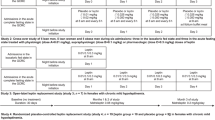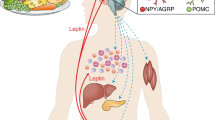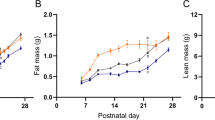Abstract
Background:
The adipokine hormone, leptin, is a major component of body weight homeostasis. Numerous studies have been performed administering recombinant mouse leptin as an experimental reagent; however, the half-life of circulating leptin following exogenous administration of recombinant mouse leptin has not been carefully evaluated.
Methods:
Exogenous leptin was administered (3 mg leptin per kg body weight) to 10-week-old fasted non-obese male mice and plasma was serially collected at seven time points; plasma leptin concentration was measured by enzyme-linked immunosorbent assay at each time point to estimate the circulating half-life of mouse leptin.
Results:
Under the physiological circumstances tested, the half-life of mouse leptin was 40.2 (±2.2) min. Circulating leptin concentrations up to 1 h following exogenous leptin administration were 170-fold higher than endogenous levels at fasting.
Conclusions:
The half-life of mouse leptin was determined to be 40.2 min. These results should be useful in planning and interpreting experiments employing exogenous leptin. The unphysiological elevations in circulating leptin resulting from widely used dosing regimens for exogenous leptin are likely to confound inferences regarding some aspects of the hormone’s clinical biology.
This is a preview of subscription content, access via your institution
Access options
Subscribe to this journal
Receive 12 print issues and online access
$259.00 per year
only $21.58 per issue
Buy this article
- Purchase on Springer Link
- Instant access to full article PDF
Prices may be subject to local taxes which are calculated during checkout



Similar content being viewed by others
References
Myers MG, Leibel RL. In: De Groot LJ, Beck-Peccoz P, Chrousos G et al. (Eds). Lessons from Rodent Models of Obesity. MDText.com, Endotext: South Dartmouth, 2015.
Rosenbaum M, Leibel RL . 20 years of leptin: role of leptin in energy homeostasis in humans. J Endocrinol 2014; 223: T83–T96.
Montague CT, Farooqi IS, Whitehead JP, Soos MA, Rau H, Wareham NJ et al. Congenital leptin deficiency is associated with severe early-onset obesity in humans. Nature 1997; 387: 903–908.
Clement K, Vaisse C, Lahlou N, Cabrolk S, Pelloux V, Cassuto D et al. A mutation in the human leptin receptor gene causes obesity and pituitary dysfunction. Nature 1998; 392: 398–401.
Zhang Y, Proenca R, Maffei M, Barone M, Leopold L, Friedman JM . Positional cloning of the mouse obese gene and its human homolog. Nature 1994; 372: 425–432.
Chua SC, Chung WK, Wu-Peng XS, Zhang Y, Liu S-M, Tartaglia L et al. Phenotypes of mouse diabetes and rat fatty due to mutations in the OB (Leptin) receptor. Science 1996; 271: 994–996.
Maskari MYA, Alnaqdy AA . Correlation between serum leptin levels, body mass index and obesity in Omanis. Sultan Qaboos Univ Med J 2006; 6: 27–31.
Lönnqvist F, Nordfors L, Jansson Mr, Thörne A, Schalling M, Arner P . Leptin secretion from adipose tissue in women relationship to plasma levels and gene expression. J Clin Invest 1997; 99: 2398–2404.
Ravussin Y, LeDuc CA, Watanabe K, Leibel RL . Effects of ambient temperature on adaptive thermogenesis during maintenance of reduced body weight in mice. Am J Physiol Regul Integr Comp Physiol 2012; 303: R438–R448.
Ahima' RS, Flier JS . Adipose tissue as an endocrine organ. Trends Endocrinol Metab 2000; 11: 327–332.
Lee MJ, Fried SK . Integration of hormonal and nutrient signals that regulate leptin synthesis and secretion. Am J Physiol Endocrinol Metab 2009; 296: E1230–E1238.
Lee M-J, Yang R-Z, Gong D-W, Fried SK . Feeding and insulin increase leptin translation. J Biol Chem 2007; 282: 77–80.
Cammisotto PG, Bukowiecki LJ, Deshaies Y, Bendayan M . Leptin biosynthetic pathway in white adipocytes. Biochem Cell Biol 2006; 84: 207–214.
Ahima RS, Flier JS . Adipose tissue as an endocrine organ. Trends Endocrinol Metab 2000; 11: 327–332.
Fruhbeck G . Intracellular signalling pathways activated by leptin. Biochem J 2006; 393 ((Pt 1)): 7–20.
Vaisse C, Halaas J, Horvath C, Darnell J, Stoffel M, Friedman J . Leptin activation of Stat3 in the hypothalamus of wild-type and ob/ob mice but not db/db mice. Nat Genet 1996; 14: 95–97.
Schwartz MW, Seeley RJ, Woods SC, Weigle DS, Campfield LA, Burn P et al. Leptin increases hypothalamic pro-opiomelanocortin mRNA expression in the rostral arcuate nucleus. Diabetes 1997; 46: 2119–2123.
Hill R, Margetic S, Pegg G, Gazzola C . Leptin: its pharmacokinetics and tissue distribution. Int J Obes 1998; 22: 765–770.
Klein S, Coppack SW, Mohamed-Ali V, Landt M . Adipose tissue leptin production and plasma leptin kinetics in humans. Diabetes 1996; 45: 984–987.
Ahima RS, Prabakaran D, Mantzoros CS, Qu D, Lowell BB, Maratos-Flier E et al. Role of leptin in the neuroendocrine response to fasting. Nature 1996; 382: 250–252.
Brabant G, Nave H, Mayr B, Behrend M, Harmelen VV, Arber P . Secretion of free and protein-bound leptin from subcutaneous adipose tissue of lean and obese women. J Clin Endocrinol Metab 2002; 87: 3966–3970.
Lammert A, Kiess W, Bottner A, Glasow A, Kratzsch J . Soluble leptin receptor represents the main leptin binding activity in human blood. Biochem Biophys Res Commun 2001; 283: 982–988.
Chen K, Li F, Li J, Cai H, Strom S, Bisello A et al. Induction of leptin resistance through direct interaction of C-reactive protein with leptin. Nat Med 2006; 12: 425–432.
Bornstein S, Abu-Asab M, Glasow A, Päth G, Hauner H, Tsokos M et al. Immunohistochemical and ultrastructural localization of leptin and leptin receptor in human white adipose tissue and differentiating human adipose cells in primary culture. Diabetes 2000; 49: 532–538.
Cohen P, Yang G, Yu X, Soukas AA, Wolfish CS, Friedman JM et al. Induction of leptin receptor expression in the liver by leptin and food deprivation. J Biol Chem. 2005; 280: 10034–10039.
Chua SC, Koutras IK, Han L, Liu S-M, Kay J, Young SJ et al. Fine structure of the murine leptin receptor gene: splice site suppression is required to form two alternatively spliced transcripts. Genomics 1997; 45: 264–270.
Maamra M, Bidlingmaier M, Postel-Vinay M, Wu Z, Strasburger C, Ross R . Generation of human soluble leptin receptor by proteolytic cleavage of membrane-anchored receptors. Endocrinology 2001; 142: 4389–4393.
Huang L, Wang Z, Li C . Modulation of circulating leptin levels by its soluble receptor. J Biol Chem 2001; 276: 6343–6349.
Yang G, Ge H, Boucher A, Yu X, Li C . Modulation of direct leptin signaling by soluble leptin receptor. Mol Endocrinol 2004; 18: 1354–1362.
Mistrík P, Moreau F, Allen J . BiaCore analysis of leptin-leptin receptor interaction: evidence for 1:1 stoichiometry. Anal Biochem 2004; 327: 271–277.
Bates SH, Stearns WH, Dundon TA, Schubert M, Tso AWK, Wang Y et al. STAT3 signalling is required for leptin regulation of energy balance but not reproduction. Nature 2003; 421: 856–859.
Ravussin Y, LeDuc CA, Watanabe K, Mueller BR, Skowronski A, Rosenbaum M et al. Effects of chronic leptin infusion on subsequent body weight and composition in mice: can body weight set point be reset? Mol Metab 2014; 3: 432–440.
Qiu J, Ogus S, Lu R, Chehab F . Transgenic mice overexpressing leptin accumulate adipose mass at an older, but not younger, age. Endocrinology 2001; 142: 342–358.
Balland E, Dam J, Langlet F, Caron E, Steculorum S, Messina A et al. Hypothalamic tanycytes are an ERK-gated conduit for leptin into the brain. Cell Metab 2014; 19: 293–301.
Rodríguez E, Blázquez J, Guerra M . The design of barriers in the hypothalamus allows the median eminence and the arcuate nucleus to enjoy private milieus: the former opens to the portal blood and the latter to the cerebrospinal fluid. Peptides 2010; 4: 757.
Roujeau C, Jockers R, Dam J . New pharmacological perspectives for the leptin receptor in the treatment of obesity. Front Endocrinol 2014; 5: 167.
Uotani S, Bjørbæk C, Tornøe J, Flier JS . Functional properties of leptin receptor isoforms internalization and degradation of leptin and ligand-induced receptor downregulation. Diabetes 1999; 48: 279–286.
Stratigopoulos G, LeDuc CA, Cremona ML, Chung WK, Leibel RL . Cut-like Homeobox 1 (CUX1) regulates expression of the fat mass and obesity-associated and Retinitis Pigmentosa GTPase Regulator-interacting Protein-1-like (RPGRIP1L) genes and coordinates leptin receptor signaling. J Biol Chem 12010; 286: 2155–2170.
Gan L, Guo K, Cremona M, McGraw T, Leibel R, Zhang Y . TNF-α up-regulates protein level and cell surface expression of the leptin receptor by stimulating its export via a PKC-dependent mechanism. Endocrinology 2012; 153: 5821–5833.
Seo S, Guo D-F, Bugge K, Morgan DA, Rahmouni K, Sheffield VC . Requirement of Bardet-Biedl syndrome proteins for leptin receptor signaling. Hum Mol Genet 2009; 18: 1323–1331.
Byun K, Gil SY, Namkoong C, Youn BS, Huang S, Shin MS et al. Clusterin/ApoJ enhances central leptin signaling through Lrp2‐mediated endocytosis. EMBO Rep 2014; 15: 801–808.
Björnholm M, Münzberg H, Leshan R, Villanueva E, Bates S, Louis G et al. Mice lacking inhibitory leptin receptor signals are lean with normal endocrine function. J Clin Invest 2007; 117: 1354–1360.
Enriori PJ, Sinnayah P, Simonds SE, Rudaz CG, Cowley MA . Leptin action in the dorsomedial hypothalamus increases sympathetic tone to brown adipose tissue in spite of systemic leptin resistance. Neurobiol Dis 2011; 31: 12189–12197.
Ernst MB, Wunderlich CM, Hess S, Paehler M, Mesaros A, Koralov SB et al. Enhanced Stat3 activation in POMC neurons provokes negative feedback inhibition of leptin and insulin signaling in obesity. Neurobiol Dis 2009; 29: 11582–11593.
Stratigopoulos G, Carli JFM, O’Day DR, Wang L, LeDuc CA, Lanzano P et al. Hypomorphism for RPGRIP1L, a ciliary gene vicinal to the FTO locus, causes increased adiposity in mice. Cell Metab 2014; 19: 767–779.
Ravussin Y, Gutman R, Diano S, Shanabrough M, Borok E, Sarman B et al. Effects of chronic weight perturbation on energy homeostasis and brain structure in mice. Am J Physiol Regul Integr Comp Physiol 2011; 300: R1352–R1362.
Rosenbaum M, Goldsmith R, Bloomfield D, Magnano A, Weimer L, Heymsfield S et al. Low-dose leptin reverses skeletal muscle, autonomic, and neuroendocrine adaptations to maintenance of reduced weight. J Clin Invest 2005; 115: 3579–3586.
Galgani J, Greenway F, Caglayan S, Wong M, Licinio J, Ravussin E . Leptin replacement prevents weight loss-induced metabolic adaptation in congenital leptin-deficient patients. J Clin Endocrinol Metab 2010; 95: 851–855.
Hambly C, Duncan J, Archer Z, Moar K, Mercer J, Speakman J . Repletion of TNFα or leptin in calorically restricted mice suppresses post-restriction hyperphagia. Dis Models Mech 2012; 5: 83–94.
Knight Z, Hannan K, Greenberg M, Friedman J . Hyperleptinemia is required for the development of leptin resistance. PLoS One 2010; 5: e11376.
Montez J, Soukas A, Asilmaz E, Fayzikhodjaeva G, Fantuzzi G, Friedman J . Acute leptin deficiency, leptin resistance, and the physiologic response to leptin withdrawal. Proc Natl Acad Sci 2005; 102: 2537–2542.
Acknowledgements
We thank Yiying Zhang, Jayne Martin Carli and Yann Ravussin for helpful discussions and Benjamin J Burnett for assistance in half-life modeling. We thank the Foundation for Prader-Willi Research, the Russell Berrie Foundation and RO1 DK52431 for funding.
Author information
Authors and Affiliations
Corresponding author
Ethics declarations
Competing interests
The authors declare no conflict of interest.
Rights and permissions
About this article
Cite this article
Burnett, L., Skowronski, A., Rausch, R. et al. Determination of the half-life of circulating leptin in the mouse. Int J Obes 41, 355–359 (2017). https://doi.org/10.1038/ijo.2016.238
Received:
Revised:
Accepted:
Published:
Issue Date:
DOI: https://doi.org/10.1038/ijo.2016.238
This article is cited by
-
Metabolic effects of leptin receptor knockdown or reconstitution in adipose tissues
Scientific Reports (2019)
-
Exogenous leptin affects sperm parameters and impairs blood testis barrier integrity in adult male mice
Reproductive Biology and Endocrinology (2018)
-
Leptin Increases Particle-Induced Osteolysis in Female ob/ob Mice
Scientific Reports (2018)



